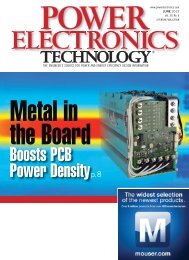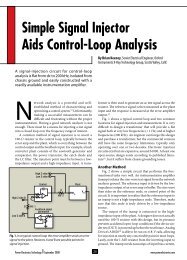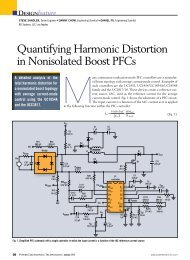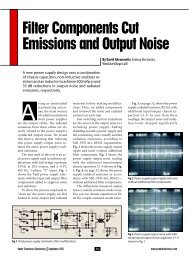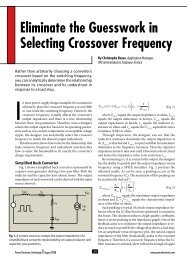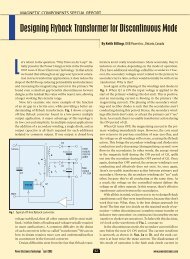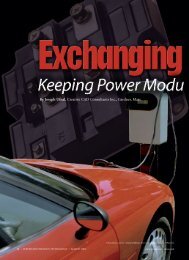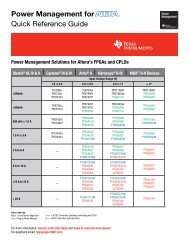Power Electronics Technology September 2004 www ...
Power Electronics Technology September 2004 www ...
Power Electronics Technology September 2004 www ...
Create successful ePaper yourself
Turn your PDF publications into a flip-book with our unique Google optimized e-Paper software.
<strong>Power</strong> <strong>Electronics</strong> <strong>Technology</strong> <strong>September</strong> <strong>2004</strong> 70<br />
<strong>www</strong>.powerelectronics.com
T<br />
o list the highlights of Eric Lidow’s career<br />
in power electronics is to chronicle many<br />
of this industry’s milestones dating back to<br />
the introduction of power semiconductors.<br />
In a career spanning more than six decades,<br />
the founder and chairman of International Rectifier (IR)<br />
has played a leading role in the development<br />
and commercialization<br />
of several cornerstone technologies.<br />
Most notable are his efforts relating<br />
to photovoltaic cells, selenium<br />
photocells and rectifiers, silicon<br />
controlled rectifiers (SCRs),<br />
power germanium rectifiers, and<br />
power MOSFETs.<br />
<strong>Power</strong> MOSFETs in particular<br />
revolutionized the power electronics<br />
field, fueling a shift from bipolar<br />
transistors to more-efficient<br />
MOSFET devices based on IR’s<br />
hexagonal cell structure, known<br />
under its trade name “HEXFET.”<br />
Today, the power MOSFETs pio-<br />
neered by IR under their founder’s<br />
leadership represent a $4 billion<br />
industry.<br />
However, the HEXFET provides only one example of<br />
Lidow’s impact on the business of power electronics.<br />
Lidow’s career has included a host of business-related firsts<br />
that helped grow the power electronics industry. Lidow<br />
founded two of the earliest power semiconductor manufacturers,<br />
starting in 1940 with Selenium Corp., the first<br />
U.S. producer of photovoltaic cells. In 1947, Lidow began<br />
his second new venture, International Rectifier, which<br />
would become the first company to mass-produce selenium<br />
photocells and rectifiers.<br />
Among the first to realize the potential of power semiconductors<br />
as an international enterprise, Lidow expanded<br />
IR’s production capabilities by establishing semiconductor<br />
fabs in other countries. IR was among the first companies<br />
to manufacture semiconductors in England (1956),<br />
By David Morrison, Editor, <strong>Power</strong> <strong>Electronics</strong> <strong>Technology</strong><br />
Eric Lidow cofounded International Rectifier with his<br />
father, Leon, who is shown here in the background.<br />
Italy (1957), Japan (1958) and India (early 1960s).<br />
In recent years, the company Lidow founded has expanded<br />
its development of power components to include<br />
application-oriented power ICs and systems, while continuing<br />
to develop discrete component technology through<br />
innovations in semiconductor and packaging design. All<br />
of these developments have been<br />
fostered with the idea of adding<br />
value to the company’s products,<br />
a fundamental concept that Lidow<br />
grasped accidentally as a young<br />
engineering student.<br />
Unlikely Beginnings<br />
Eric Lidow was born 91 years<br />
ago in the Lithuanian city of<br />
Vilnius, which was then part<br />
of Russia. Soon after his birth, his<br />
father, Leon, joined the Russian<br />
army and moved his wife and<br />
young son to Russia. When Lidow<br />
was nine, the family moved back<br />
to Vilnius, which had come under<br />
Polish control.<br />
It was there in Vilnius that<br />
Lidow attended middle and high<br />
school (gymnasium). At first glance, his early education<br />
would seem to offer little encouragement for a budding<br />
engineer. Lidow encountered no mentor in science or<br />
technology. Moreover, neither the Catholic priests who<br />
instructed him nor his peers were technically inclined.<br />
As Lidow recounted in a recent interview, “Most of my<br />
friends wanted to be prosperous attorneys or doctors or<br />
businessmen.”<br />
However, Lidow, born in a place where borders and<br />
governments were continually shifting, wanted to pursue<br />
a career that would not be limited by geography or politics.<br />
This tended to point him away from opportunities in<br />
banking or the law, and medicine was not something that<br />
appealed to him. Seeking something with an “international<br />
flavor” and with an inclination toward applied physics and<br />
<strong>www</strong>.powerelectronics.com 71<br />
<strong>Power</strong> <strong>Electronics</strong> <strong>Technology</strong> <strong>September</strong> <strong>2004</strong>
LIFETIME ACHIEVEMENT AWARD<br />
mathematics, Lidow gravitated<br />
York penniless with no knowl-<br />
toward a technical career.<br />
edge of English. To make mat-<br />
Following graduation from<br />
ters worse, he soon discovered<br />
gymnasium in 1931, Lidow<br />
that his master’s degree in elec-<br />
moved to Germany and entrical<br />
engineering would be of<br />
rolled in the Berlin Technical<br />
no help in landing one of the<br />
University, where his engi-<br />
available jobs as a busboy or<br />
neering studies focused on<br />
dishwasher.<br />
heavy electric power. Although<br />
However, the young im-<br />
his parents had only a vague<br />
migrant’s first break came<br />
conception of electrical engi-<br />
when he learned of an openneering,<br />
they trusted their<br />
ing for a foreman at Automatic<br />
son’s judgment. Still, Lidow<br />
Winding (which later became<br />
recalls that his father offered<br />
part of General Instruments)<br />
him two memorable admoni-<br />
in Newark, N.J. While waiting<br />
tions when he left home.<br />
for an interview at the com-<br />
“He said, ‘Remember that<br />
pany, a secretary ran into the<br />
your life will depend on your<br />
office where Lidow sat and<br />
contribution to society.’ And<br />
inquired frantically whether<br />
‘Don’t marry a rich woman.’”<br />
anyone there spoke German.<br />
Despite the humor of the lat-<br />
As the secretary explained, the<br />
ter advice, Lidow understood<br />
chairman of the company<br />
the serious message underly-<br />
was meeting with important<br />
ing both of his father’s instruc-<br />
German-speaking visitors and<br />
tions. In the second instance,<br />
desperately needed a translator<br />
the father wanted to warn his Under Lidow’s guidance, IR has developed and commercialized to facilitate the meeting.<br />
son that a wealthy mate would numerous power semiconductor technologies.<br />
Lidow, who by then had<br />
expect a lavish lifestyle. How-<br />
learned English, informed the<br />
ever, notes Lidow, his father also wanted him to under- secretary that he spoke German. He was promptly hired<br />
stand that “wealth is so transient, while knowledge is not.” on a temporary basis as an interpreter. But Lidow so<br />
The value of knowledge would be made real to Lidow impressed his bosses that they offered him a manager’s<br />
by a fortuitous mishap he experienced as an engineering position. Initially put in charge of nine workers, Lidow had<br />
student. Lidow recalls, “I decided to go into semiconduc- 120 people reporting to him after just one year. Given that<br />
tors because of a very strange incident. In our school, if increase in responsibilities, Lidow was fully expecting a raise<br />
you ruined a piece of equipment, you had to pay for it. when his boss asked to meet with him.<br />
So, when I ruined a light meter—a very fancy exposure Unfortunately, his boss had other expectations. “You<br />
meter—I had to pay my monthly allowance for it, which know, I’ve had very good reports on you,” said the boss,<br />
was equivalent to $1300 now.<br />
“and you have just about my build.” His boss then opened<br />
“Then a professor gave me the piece that I had ruined. a closet, removed a dirty white suit and said, “There’s noth-<br />
It was a photocell made of copper oxide, the size of a dollar ing wrong with this suit that the cleaner can’t fix.”<br />
and about one-eighth of an inch thick. Not too heavy, only Unimpressed with his reward, Lidow left the meeting<br />
about 40 cents worth of copper, mostly know how. And I at Automatic Winding and discarded the suit. But he came<br />
had to pay $1300! I looked at it and realized that this was away from this encounter feeling that his talents would be<br />
value added. This is what I should be producing.”<br />
put to better use elsewhere. To that end, Lidow withdrew<br />
That experience prompted Lidow to focus his studies $34 from his savings account—his complete savings—and<br />
on all things relating to photoelectric cells. Later, Lidow’s placed an advertisement in the New York Times announc-<br />
extensive knowledge of these devices would provide his ing his availability for work as a “photoelectric expert.” This<br />
entry into the semiconductor field.<br />
led Lidow to his first promising position in Los Angeles,<br />
Though he completed his electrical engineering studies where he was hired by Carl Laemmle of Universal Studios<br />
in 1937, his opportunities for further education in Ger- to develop photoelectric control for printing film.<br />
many were limited by the country’s buildup to war. As time That opportunity fell through, however, because<br />
went by, one technical lecture after another was being closed Laemmle died before Lidow arrived on the job. Never-<br />
off to foreign students because of “military implications.” theless, the trip to California was not in vain as one of<br />
With his opportunities in Germany dwindling, Lidow Laemmle’s employees suggested to Lidow that they start<br />
immigrated to the United States soon after graduation. their own venture to develop photoelectric cells. He<br />
Although he spoke four languages, Lidow arrived in New approached Lidow with $2000, providing the seed money<br />
<strong>Power</strong> <strong>Electronics</strong> <strong>Technology</strong> <strong>September</strong> <strong>2004</strong> 72<br />
<strong>www</strong>.powerelectronics.com
LIFETIME ACHIEVEMENT AWARD<br />
for Selenium Corp. of America, which Lidow founded in<br />
1940.<br />
From Photoelectric Cells to Rectifiers<br />
Initially, Selenium Corp. developed its business by supplying<br />
photoelectric cells to the U.S. government. These<br />
photoelectric cells found use in exposure meters. But when<br />
World War II broke out, demand for those meters dried<br />
up. Nevertheless, the government needed a related type of<br />
device, selenium rectifiers. After a meeting in Washington,<br />
where Noble laureate Enrico Fermi interviewed him, Lidow<br />
obtained the government’s orders for the high-voltage selenium<br />
rectifiers that would be needed for the war effort.<br />
At the time Selenium Corp. produced the new rectifiers,<br />
Lidow did not know how they ultimately would be used.<br />
Years later, he learned that the rectifiers served as proximity<br />
fuses in munitions, causing them to explode before<br />
impact.<br />
By the war’s end, Selenium Corp. had grown to approximately<br />
200 employees. However, Lidow learned that launching<br />
his first new business was not without obstacles.<br />
The pioneering nature of Lidow’s work on photoelectric<br />
cells and later selenium rectifiers meant that all manufacturing<br />
processes needed to be developed from scratch.<br />
Lidow explains, “Nothing was fixed. You had to develop<br />
every single step, including how to apply selenium, how to<br />
oxidize it and how to apply the barrier layer.”<br />
Selenium Corp. was actually co-owned by Lidow with<br />
two other individuals. In 1944, Lidow’s partners sold their<br />
shares in the company to Sperry Corp. But Lidow, for his<br />
part, retained his shares and went to work for Sperry Corp.<br />
Vickers Division, where he became a vice president of<br />
engineering. Lidow remained in that position until 1947<br />
when he sold his stock in the company.<br />
Another Journey Begins<br />
In August of that same year, Lidow combined the<br />
proceeds of the sale with matching funds from another<br />
investor to start International Rectifier (IR), which he<br />
cofounded with his father. The senior Lidow was an intelligent,<br />
experienced businessman whose guidance was<br />
valued greatly by his son. As with other seminal events<br />
in his career, there was an element of fortune here for<br />
Lidow. Only recently had his father had made his way to<br />
America, having survived the Holocaust in Europe.<br />
After a brief start in Englewood, Calif., IR soon moved<br />
to El Segundo, Calif., where it has been headquartered ever<br />
since. When IR began, Lidow was careful to develop products<br />
that would be different from those he produced at<br />
Sperry. “We established ourselves as making much bigger<br />
rectifiers than they had at Vickers,” says Lidow. “The new<br />
business was oriented toward heavy industry and higher<br />
power.”<br />
Some of the first applications for these high-power<br />
selenium rectifiers were in plating plants and mining units.<br />
Another application was in battery chargers for cars,<br />
making IR one of the first companies to manufacture trickle<br />
chargers.<br />
The same year that IR was born, Bell Labs invented the<br />
first transistor. However, Lidow was then unaware of the<br />
discovery. “Frankly, I didn’t even know about it at the time,<br />
because transistors were so far from our basic power management;<br />
they were out of our area,” says Lidow. The first<br />
contact Lidow made with Bell Laboratories was in 1953.<br />
Bell Labs had developed a diffusion system in silicon, which<br />
IR needed and licensed. That technology was used to produce<br />
germanium rectifiers, the successors to IR’s selenium<br />
rectifiers. In making the switch, IR became one of the first<br />
vendors to commercialize power germanium rectifiers.<br />
Later, the company would switch from germanium to<br />
silicon when it introduced silicon rectifiers in 1956.<br />
Another technological shift came when IR added transistors<br />
to its product line. “It was becoming obvious that<br />
transistors could do many functions that we attributed to<br />
thyristors,” says Lidow, referring to the SCR technology that<br />
IR helped to commercialize in the 1950s. “Transistors could<br />
do everything that thyristors could do and better, in a much<br />
smaller package.”<br />
But after just a few years of manufacturing bipolars, the<br />
company was preparing for another technological leap.<br />
Lidow’s son, Alex, who was then a recent graduate of<br />
Stanford and is now IR’s CEO, felt that the future belonged<br />
to field effect transistors (FETs, also known as MOSFETs).<br />
While one other company was building MOSFETs at<br />
the time, their “V-groove” structure made it impossible to<br />
build a big transistor. IR’s new HEXFET design, developed<br />
by Alex and a team of IR engineers, enabled the company<br />
to build the largest FETs available. As its name implies, the<br />
HEXFET employed a six-sided structure that would be<br />
more space efficient than existing designs.<br />
IR also built what was then the largest facility for transistors<br />
anywhere—a 230,000-sq. ft. factory that cost nearly<br />
$100 million. At the time the facility was completed, the<br />
total world demand for MOSFETs was no more than 20%<br />
of the factory’s capacity. Acknowledging the boldness of<br />
building such a big facility for a product with so little market,<br />
one visitor commented on the fab, “It was an engineer’s<br />
dream and an accountant’s nightmare.”<br />
In 1979, when IR debuted its HEXFETs, a name that<br />
became synonymous with MOSFETs in the early years, the<br />
company faced a difficult task in converting engineers from<br />
the familiar bipolars. “We had to fight for almost every<br />
application,” says Lidow. However, for most designs, the<br />
performance advantages of the MOSFETs would prove<br />
convincing to customers. Still, to win engineers over to the<br />
HEXFET, IR had to develop a series of applications. Facing<br />
even greater resistance internally from a sales force schooled<br />
in rectifiers, IR was forced to sell the MOSFETs through<br />
outside sales reps.<br />
When asked a quarter of a century after the HEXFET’s<br />
introduction whether it might be time for another radically<br />
new transistor design, Lidow responds in the affir-<br />
<strong>Power</strong> <strong>Electronics</strong> <strong>Technology</strong> <strong>September</strong> <strong>2004</strong> 74<br />
<strong>www</strong>.powerelectronics.com
mative. “We stuck with the old concept long enough,” says<br />
Lidow. “If you talk to our engineers, they feel that the basic<br />
field effect transistor is a mature process and a mature<br />
product. But I don’t see anything new outside of better<br />
geometries, more transistors per square inch and possibly<br />
thinner silicon.”<br />
“I do feel there’s a lot of possibility in packaging,” he<br />
continues. “When you take a small piece of silicon and put<br />
a big bulk of plastic over it, that is not an effective way to<br />
package. So, there will be some changes in packaging. That<br />
will necessitate better passivation of surfaces.”<br />
Because of IR’s success with MOSFETs, the devices<br />
became commodities, affecting an evolution in the<br />
company’s mission. “With our success in field effect transistors,<br />
we pushed the world forward in technology and<br />
made this particular technology available to everybody. And<br />
that makes things possible that were not possible before.<br />
Everything is smaller, more efficient and requires less<br />
power.”<br />
As Lidow explains, the next step would be to pursue<br />
these same goals with systems, particularly in motion control<br />
and in lighting where the potential energy savings are<br />
great and where IR has traditionally sought to improve efficiency.<br />
Automotive, an area related to motion control, also<br />
presents opportunities for energy savings. For its initial<br />
foray into system-level designs, the company leveraged its<br />
LIFETIME ACHIEVEMENT AWARD<br />
experience in high voltage to develop high-voltage ICs, but<br />
from there went on to develop low-voltage components.<br />
Despite his many years in the power semiconductor industry,<br />
Lidow is still excited about his work. “I like to be in<br />
the forefront,” he explains. “It means that our company is<br />
not a ‘me-too’ company. It affected our profitability in the<br />
past because we always wanted to be first. But then, we created<br />
an industry that didn’t exist. We’re doing this now<br />
again with the DirectFET. And we’re working on alternative<br />
substrate materials, which is exciting. Also, I’m very<br />
interested in getting more electricity in the automobile. To<br />
me, this is almost a passion.” Lidow, who currently drives a<br />
leased Toyota electric car, notes that his motivation for<br />
improving automobile efficiency is the desire to diminish<br />
our dependence on foreign oil.<br />
In addition to his passion for technology, Lidow finds<br />
continued motivation in supporting the people who are<br />
responsible for IR’s success.<br />
“We recognize one thing. This is why I’m sticking<br />
around, because I want to see that this is preserved:<br />
The people are the most important ingredient of the<br />
company—not the equipment, not the real estate, not the<br />
technology. You have to realize that people are motivated<br />
differently. Don’t introduce bureaucratic things—be able<br />
to make exceptions, if necessary. To me, this is terribly<br />
important.” PETech<br />
CIRCLE 241 on Reader Service Card or freeproductinfo.net/pet<br />
<strong>www</strong>.powerelectronics.com 75<br />
<strong>Power</strong> <strong>Electronics</strong> <strong>Technology</strong> <strong>September</strong> <strong>2004</strong>




